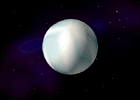 Ariel is the planet closest to the sun, and appears to be white
and ghostly (with the help of rare telescopic equipment).
It is named after Ariel, Messenger of the Gods, and Goddess of the Spirit Realm.
Ariel is the planet closest to the sun, and appears to be white
and ghostly (with the help of rare telescopic equipment).
It is named after Ariel, Messenger of the Gods, and Goddess of the Spirit Realm.
2.0 Morpheus
More Details about Morpheus (SPOILERS)
3.0 Ashtoreth
Sinaian and Abaddonian explorers have set up a city within an ancient Sifran complex built into a rocky spire that has been dubbed "Gateway Island", with the Crystal Chamber and the Gateway at the top. They have made contact with local sapient life-forms known as "Mariners" -- merman and mermaid types that have feline features on their upper halves, and dolphin or porpoise-like lower torsos and tails. Ashtoreth also sports a wide variety of ocean life, some of it quite bizarre, as well as many types of birds and other flying creatures.
More Details about Ashtoreth (SPOILERS)
4.0 Sinai
5.0 Abaddon
The desert sands are rich in concentrations of iron, making metal quite
abundant, unlike on Sinai. There are several civilizations known to be
on Abaddon, comprised of races that parallel those on Sinai, suggesting
similar origins.
Abaddon is named after the Olympian God of Fire, who is also known as the
God of War and Destruction.
More Details about Abaddon (SPOILERS)
6.0 Fortunatis
Fortunatis is named after the God of Fortune in Olympian mythology, a bringer of
curses and blessings, and known as the "mischief maker" in the Olympian
pantheon.
7.0 Arcadia
Colonies have been established on Arcadia in recent years close to the Gateway
Chamber on that world. One is a Kampfzengruppe outpost shared with emissaries of
the Khattan Emir, heavily fortified, but also serving as a science station. Another is
a semi-permanent research outpost of Rephidim Temple. A third is an actual colony,
mostly populated by Savanites that have relocated to this lush frontier world, where
they can live free and (for now) without fear of attack by those who think ill of their
new-found freedoms.
8.0 Logos
9.0 Behemoth
10.0 Dagh/Quicksilver
11.0 Kasaris/Ylem
12.0 Primus (The Sun)
13.0 The Gateways
The gateways to the various planets of the Primus System have a hub located
at the Gateway Tower in the Forbidden Zone of Himaat on the world of Sinai.
This Gateway Tower, though it shows signs of being damage (i.e., the top of the
tower has been broken off), still functions sufficiently to provide passage
to several worlds.
The base of the tower has a single "window" providing entrance, made of crystal.
When the window is touched by a sapient being, it shatters as if broken, and then
the shards retract into the frame, providing an opening for passage. The shards
then appear again, and seal, forming a complete window.
The interior of the chamber is made up of glowing crystals, some with a semi-liquid
appearance, which are associated with many Sifras and First Ones sites. Floating
in the center of the chamber are glowing orbs that correspond to Primus (the Sun),
and the eleven planets of the Primus System. The room is ringed by twelve archways
which frame twelve windows -- one of which is the doorway outside.
When someone approaches one of the archways, the other windows (including the one
leading outside) darken and solidify, while the one being approached lights up,
showing a view of the world the gateway leads to. The north window appears to
lead directly to the sun, Primus, and activating it causes the room to quickly fill
with blinding light and even heat. (No transfer of heat has been detected from
any of the other windows, nor any sound.) Continuing in clockwise direction
from this window, the windows lead to each one of the planets in the order of
their position away from the sun, starting with Ariel in the one o' clock position,
with Sinai in the four o' clock position, and ending with Kasaris/Ylem in the
eleven o' clock position.
When a window is activated, the appropriate phantom orb representing that planet
brightens, and a thin line of energy stretches between the orb representing Sinai
and that particular world. If a sapient being touches the window, a gateway is
established between Sinai and that world. A person or thing can then pass through
the gateway, being "sucked" through to the other world. The sensations reported
by explorers are that of being stretched out, and then flying up past the Procession
and through the void of space at impossible speeds, being conscious the
whole while. This sometimes prompts stomach distress, so explorers are advised
not to use the gateway on a full stomach.
Once a gateway is established, no other gateways can be established, and the link
is sustained for a time, until the lights in the Gateway Tower will begin to dim,
and then darken entirely. For a period of approximately one day (which varies
due to unknown factors), the Gateway Tower will be completely dark and unusable,
until it "recharges", and the lights slowly return.
Each of the Gateway Chambers on the other worlds appears to be a copy of that
on Sinai, with the exception that one of the windows is a gateway back to Sinai,
while the other windows all are clear and show views of the surrounding world. They
"break" upon touching and open up (then close and re-seal) in the same way as the
"Sinai" window that provides entrance to the Gateway Tower.
Although gravity varies on each of these worlds, gravity inside the Gateway
Chamber is comparable to that on Sinai, and it maintains a breathable oxygen-rich
atmosphere, at a moderate temperature (though it experiences some variations based
on the temperature of the outside area). Although the process has not been
observed, it is believed that the Chambers have some sort of cleaning mechanism,
as dust and dirt blown into the chambers during early expeditions have been reported
cleaned away when later explorers investigate.
The gateways appear to be stable, but at least one anomaly has been reported with
the Abaddon gateway: Usually, it is possible for someone on the opposite side of
a "window" to be visible. However, the Abaddon window seems to be somehow "out of
alignment", as sometimes it shows a view through one of the other windows of the
Chamber on the Abaddon side, rather than the opposite side of the gateway.
Back to Locations: Section 4.3
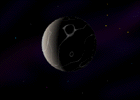 Morpheus is the planet second closest to the sun, named after the God of
Dreams. Its orbit is synchronized with that of Sinai, such that it always
appears as an illuminated crescent in the sky. Explorers of Morpheus found
it to have a very light gravity, yet somehow it manages to keep an atmosphere.
Thick layers of dust billow about like vapors, making it necessary to wear
filters or to fly above the dust clouds. Explorers reported floating
structures of stone and crystal that would change shape from time to time,
some seeming to suggest ruins of contemporary and ancient architecture on
Sinai. There is also word that a crashed vessel once capable of travelling
to the stars was found there.
Morpheus is the planet second closest to the sun, named after the God of
Dreams. Its orbit is synchronized with that of Sinai, such that it always
appears as an illuminated crescent in the sky. Explorers of Morpheus found
it to have a very light gravity, yet somehow it manages to keep an atmosphere.
Thick layers of dust billow about like vapors, making it necessary to wear
filters or to fly above the dust clouds. Explorers reported floating
structures of stone and crystal that would change shape from time to time,
some seeming to suggest ruins of contemporary and ancient architecture on
Sinai. There is also word that a crashed vessel once capable of travelling
to the stars was found there.
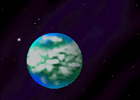 Ashtoreth is the planet third closest to the sun, named after the Olympian
Water Goddess (who was associated with Fertility, Rain, and the Oceans).
This world is covered almost entirely in water, and with barely anything in
the way of land masses to interfere with the flow of water or air, this planet is
traversed by mighty storms.
Ashtoreth is the planet third closest to the sun, named after the Olympian
Water Goddess (who was associated with Fertility, Rain, and the Oceans).
This world is covered almost entirely in water, and with barely anything in
the way of land masses to interfere with the flow of water or air, this planet is
traversed by mighty storms.
 Fourth from the sun is Sinai, the planet that most of our heroes' adventures
take place on. It so happens that in Olympian myth, there is a goddess known
as Sinai, who is the Goddess of Air, and is the patroness of travellers.
Fourth from the sun is Sinai, the planet that most of our heroes' adventures
take place on. It so happens that in Olympian myth, there is a goddess known
as Sinai, who is the Goddess of Air, and is the patroness of travellers.
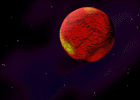 Fifth from the sun is Abaddon, a red planet that is known to not only be
habitable, but populated. It is known that magic does not function here (at
least, not as it is known on Sinai), and that higher technologies are
possible here ... though it is believed that some degree of "quantum
uncertainty" still exists. Most of the planet is desert, though it is
crisscrossed by a network of deep "canals", in which plant life can be
found, sustaining the oxygen in the atmosphere ... but also filled with
high concentrations of disease and hostile life forms, making it unacceptable
to try to live in these canal regions.
Fifth from the sun is Abaddon, a red planet that is known to not only be
habitable, but populated. It is known that magic does not function here (at
least, not as it is known on Sinai), and that higher technologies are
possible here ... though it is believed that some degree of "quantum
uncertainty" still exists. Most of the planet is desert, though it is
crisscrossed by a network of deep "canals", in which plant life can be
found, sustaining the oxygen in the atmosphere ... but also filled with
high concentrations of disease and hostile life forms, making it unacceptable
to try to live in these canal regions.
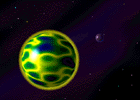 Fortunatis' orbit actually shifts from time to time, but most of the
time, it is the sixth planet from the sun, and so therefore it is considered
as such for the sake of organization. Fortunatis has been explored, and
has been discovered to have some presence of "magic" on it, but so wildly
out of control that it is useless for "spellcasting". The terrain shifts
from time to time, as "winds of change" sweep across the land, and on occasion
"Improbability Storms" cause extremely bizarre (and unlikely) events wherever
they pass. During the last expedition to this planet, a crystaline entity
nearly killed one of the explorers, so this world is considered quite hazardous.
Fortunatis' orbit actually shifts from time to time, but most of the
time, it is the sixth planet from the sun, and so therefore it is considered
as such for the sake of organization. Fortunatis has been explored, and
has been discovered to have some presence of "magic" on it, but so wildly
out of control that it is useless for "spellcasting". The terrain shifts
from time to time, as "winds of change" sweep across the land, and on occasion
"Improbability Storms" cause extremely bizarre (and unlikely) events wherever
they pass. During the last expedition to this planet, a crystaline entity
nearly killed one of the explorers, so this world is considered quite hazardous.
 Arcadia is named after the Goddess of Life and Healing, and exploration has
revealed it to have life in great abundance. The planet sports a ring, and
has a sky that appears multi-colored, but it still supports an oxygen-rich
atmosphere, and a wealth of flora and fauna -- some of which is similar to that
found on Sinai, and a great deal of which is totally alien to anything known
before. Just about everything seems to be alive. Explorers have reported
encountering what seemed to be intelligent and mobile bodies of water,
and having to negotiate with trees. Also reported was a colony of
creatures that closely resemble the Hookas of the Wandering Roams.
Arcadia is named after the Goddess of Life and Healing, and exploration has
revealed it to have life in great abundance. The planet sports a ring, and
has a sky that appears multi-colored, but it still supports an oxygen-rich
atmosphere, and a wealth of flora and fauna -- some of which is similar to that
found on Sinai, and a great deal of which is totally alien to anything known
before. Just about everything seems to be alive. Explorers have reported
encountering what seemed to be intelligent and mobile bodies of water,
and having to negotiate with trees. Also reported was a colony of
creatures that closely resemble the Hookas of the Wandering Roams.
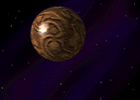 Logos is named after the God of Knowledge -- a god in Olympian mythology that
seems at times to be in contest with Primus (the King of the Gods) to determine
just which of the two is the wisest. As for this planet, it is a deep brown
in color, and gaseous.
Logos is named after the God of Knowledge -- a god in Olympian mythology that
seems at times to be in contest with Primus (the King of the Gods) to determine
just which of the two is the wisest. As for this planet, it is a deep brown
in color, and gaseous.
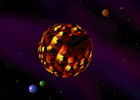 Behemoth is the largest of the planets, named after the God of Earth, also
seen as the God of Strength. For a long time, it was believed that this
planet was made out of solid stone. However, in reality, it has been
determined to be a gas giant that is encompassed by a network of crystaline
structures that form a spherical "net" around it.
Behemoth is the largest of the planets, named after the God of Earth, also
seen as the God of Strength. For a long time, it was believed that this
planet was made out of solid stone. However, in reality, it has been
determined to be a gas giant that is encompassed by a network of crystaline
structures that form a spherical "net" around it.
 Recent discoveries have suggested that a tenth planet exists in the Primus
System, beyond Behemoth. This planet is totally invisible to telescopes, and
the view through the Gateway Tower suggests a world that reflects the starry
expanse but not the light of the sun. One of the explorers dubbed this world
"Quicksilver", but some have taken to calling it "Dagh", after a dark god of
Olympian myth. This is by no means its official name, however, as astronomers
are reluctant to have a planet named after what is considered in many cultures
to be a curse word.
Recent discoveries have suggested that a tenth planet exists in the Primus
System, beyond Behemoth. This planet is totally invisible to telescopes, and
the view through the Gateway Tower suggests a world that reflects the starry
expanse but not the light of the sun. One of the explorers dubbed this world
"Quicksilver", but some have taken to calling it "Dagh", after a dark god of
Olympian myth. This is by no means its official name, however, as astronomers
are reluctant to have a planet named after what is considered in many cultures
to be a curse word.
 An eleventh planet is believed to exist in the Primus System, and possibly the
furthest away from the sun. It, too, is undetectable as of yet from Sinai,
even with the best equipment. However, through the Gateway Tower portal,
it appears to be a purplish, gaseous world. One explorer dubbed it "Ylem",
after an alien word for "the raw unformed matter that the universe is made of".
This is, as with "Dagh", an unofficial name, but for the time being, scholars
have been making use of the term. Other scholars, however, insist that a
god or goddess from the Olympian pantheon should be used to name the planet,
for the sake of tradition -- and this is likely to be Kasaris, Goddess of
Darkness.
An eleventh planet is believed to exist in the Primus System, and possibly the
furthest away from the sun. It, too, is undetectable as of yet from Sinai,
even with the best equipment. However, through the Gateway Tower portal,
it appears to be a purplish, gaseous world. One explorer dubbed it "Ylem",
after an alien word for "the raw unformed matter that the universe is made of".
This is, as with "Dagh", an unofficial name, but for the time being, scholars
have been making use of the term. Other scholars, however, insist that a
god or goddess from the Olympian pantheon should be used to name the planet,
for the sake of tradition -- and this is likely to be Kasaris, Goddess of
Darkness.
 At the center of Sinai's system is a yellow star known as Primus, named after
the King of the Gods in Olympian mythology, and considered the "wisest of the
gods" in many legends. (Since "Logos" also claimed this distinction, there
were many myths about contests between the two gods to determine who was
really the wisest. In some, Primus prevailed, in others, Logos, but
it often involved Fortunatis pulling some sort of prank to tip the scales one
way or the other.) As of yet, no explorers have been sent to Primus to
explore it, especially after a group of Joyous Wiggler cultists from the Nagai
Empire forced their way into the Gateway Tower and flung themselves through
the gateway. Observers reported that they were instantly disintegrated as
soon as they went through. Nobody has been eager to repeat the experiment.
At the center of Sinai's system is a yellow star known as Primus, named after
the King of the Gods in Olympian mythology, and considered the "wisest of the
gods" in many legends. (Since "Logos" also claimed this distinction, there
were many myths about contests between the two gods to determine who was
really the wisest. In some, Primus prevailed, in others, Logos, but
it often involved Fortunatis pulling some sort of prank to tip the scales one
way or the other.) As of yet, no explorers have been sent to Primus to
explore it, especially after a group of Joyous Wiggler cultists from the Nagai
Empire forced their way into the Gateway Tower and flung themselves through
the gateway. Observers reported that they were instantly disintegrated as
soon as they went through. Nobody has been eager to repeat the experiment.